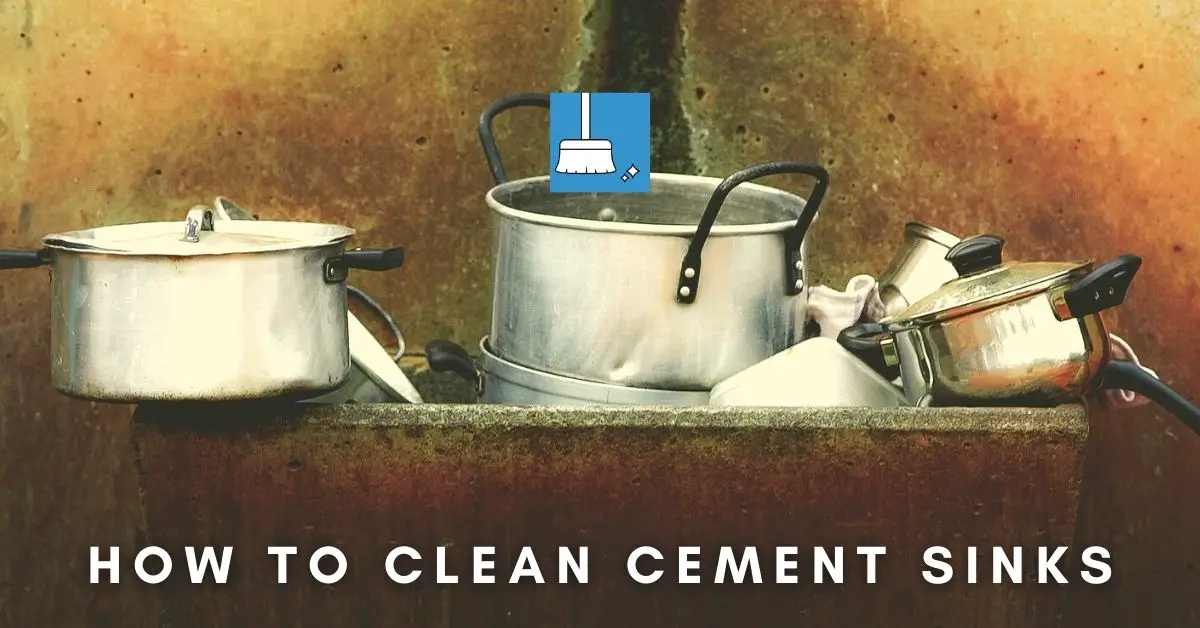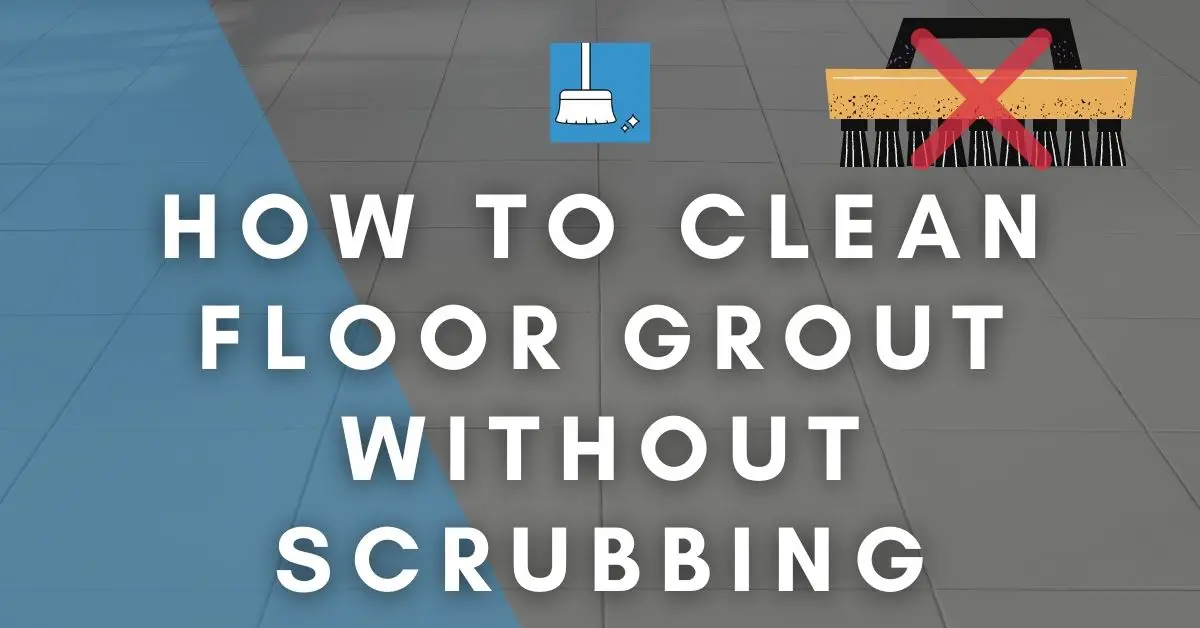Sinks, especially Kitchen sinks are one of the germiest places in the house. The percentage of fecal bacteria in a kitchen sink is more than in a toilet. (Source)
Sinks made of copper, stainless steel, enamel, clay, and stone are common to see and you’ll find methods to clean these easily.
But if you have a sink made of cement, then you are probably not able to find the right method to clean it. Let’s see how we can clean our sinks that are made of cement.
How to Clean Cement Sinks (8 Methods!)
Cement is a porous material and gets easily stained when things spill over it or when it gets stained. We’re used to seeing Cement curbings and cement benches, but these days, we have sinks made of cement as well. Kitchen sinks regularly come in contact with greasy food which is left on the dishes.
Since Cement is porous in nature, grease can seep into the sink and can be distinctly noticeable. Cement sinks need special care when it comes to cleaning.
Method 1: Using Dish Soap & Rubbing Alcohol
YOU’LL NEED
1- Dish soap
2- Sponge
3- Warm water
4- Rubbing Alcohol
5- Old rag
STEPS
STEP 1: Remove large pieces of debris and food crumbs from the sink with your hands. You may wish to use gloves for this purpose.
STEP 2: Apply dish soap to the sponge and scrub the cement sink thoroughly. Alternately, a solution of warm water and dish soap will work fine too. To use the solution, dip the sponge in the solution and scrub the sink with it in circular motions.
STEP 3: Mix a quarter cup of rubbing alcohol with water. Pour the solution into a spray bottle and spray it. Mix 1/4 cup rubbing alcohol with 2 cups water in a spray bottle and use the solution to spray the sink. Let the alcohol solution sit for 5 minutes to let it disinfect the area.
STEP 4: Rinse the sink with warm running water and clean it dry using an old rag.
Method 2: Using Baking Soda & Dish Soap
This method is for a routine cleaning or for minor stains and dirt in your cement sink.
YOU’LL NEED
1- Soft-bristled brush
2- Baking soda
3- Hot water
4- Liquid dish soap
STEPS
STEP 1: Let the cement sink dry.
STEP 2: In a bowl, mix half a cup of Baking Soda, Liquid Dish Soap, and 3-4 cups of hot water. Use a sponge to apply this solution to the cement sink and let it rest for 5 minutes.
STEP 3: Use a soft-bristled brush to give the sink a scrub.
STEP 4: Rinse the sink with running water and let it air dry.
Method 3: Using Laundry Detergent
YOU’LL NEED
1- Laundry detergent
2- Microfiber cloth / Old rag
3- Warm water
4- Towel
STEPS
STEP 1: Pour a generous amount of laundry detergent 0ver the stain and let it stay for 5 minutes.
STEP 2: Get a microfiber cloth or an old rag and moisten it with warm water. Use this cloth to scrub the stain.
STEP 3: When you see the stain coming out, rinse it with warm water and dry with a cloth or a towel.
Method 4: Using a Brush / Dremel Versa
YOU’LL NEED
1- Soft bruh / Dremel Versa
2- Warm water
3- Towel / Old rag
STEPS
STEP 1: Use a soft brush to get the dirt stuck onto your cement sink.
Alternately, you may use Dremel Versa for this purpose. It will save you the trouble of scrubbing with your hands and do a better job for those crevices and corners. Simply use the soft bristle brush for some tie and switch over to the scouring pad
STEP 2: Rinse with warm water.
STEP 3: Dry with a towel or a clean rag.
Method 5: Using Cotton Balls
This method is for getting rid of any discoloration that you might encounter on your cement sinks.
YOU’LL NEED
1- Cotton ball
2- Non-acidic cleaning solution
3- Towel
4- Paperweight
5- Warm water
STEPS
STEP 1: Take a piece of cotton or cotton balls and dip it into a mild non-acidic cleaning solution.
STEP 2: Keep the ball over the stain for about 10 minutes with a lightly heavy object placed over the ball.
STEP 3: Remove the piece of cotton and see the condition of the stain. If the stain is still there, repeat this step again.
STEP 4: Finally, gently rub away the stain from the area with a cloth and rinse the area with warm water.
STEP 5: Dry the sink with a towel.
Method 6: Using Vinegar (For Removing Mold & Mildew )
This method is used for removing Mold and Mildew in your cement sinks. Since Vinegar is acidic in nature, it is not the best for cement or concrete structures but removing mold and mildew is not something that needs to be done every day. So this method can be used once in a while.
YOU’LL NEED
1- White distilled vinegar
2- Spray bottle
3- Stiff brush
4- Hot water
STEPS
STEP 1: Mix white distilled vinegar and hot water in a spray bottle. Both should be equal in amount.
STEP 2: Spray this solution over the cement sink thoroughly. You may also want to pour some of this solution directly over the mold, where it seems to be dense.
STEP 3: Scrub the sink well with a stiff brush.
STEP 4: Rinse with hot water and let the sink dry naturally.
Method 7: Using Vinegar & Sandpaper
This method is for removing tough stains on the cement sink.
YOU’LL NEED
1- Warm water
2- Vinegar
3- Scouring pad
4- 80-120 grit Sandpaper
5- Old rag
STEPS
STEP 1: Dry the sink with a towel or a kitchen rag.
STEP 2: Apply vinegar to the cement sink directly. Scrub the stain with a scouring pad until the stains start to fade away.
STEP 3: Using 80-120 grit sandpaper, scrub away the tougher stains.
STEP 4: Rinse the sink with warm water and dry with a towel.
Method 8: Using Rust Remover (For Removing Rust Stains)
Many areas have hard water as well as high iron content. This may lead to rust buildup in the houses. Since your sinks are the ones that come in contact with this water the most, you’ll have rust over them in time.
If you have old rust stains, this method will work for you.
YOU’LL NEED
1- Rust Remover
2- Microfiber Cloth
STEPS
STEP 1: Spray the rust remover (such as Iron Out) directly over the dry cement sink.
STEP 2: Let the solution work for half a minute and then using a damp microfiber cloth, wipe the sink clean.
STEP 3: Rinse the sink with running water.
Cement Sink Maintenance – Tips
1- Daily Cleaning can be done with any non-abrasive cleaner (Soft Scrub with Bleach, dish soap, or Bar Keepers Friend).
2- Apply wax to the cement sinks twice every year. This will keep the cement sink in a smooth finish.
3- Harsh chemical cleaning agents (such as Acidic cleaners) can strip the sealants protecting your cement sink as it is porous in nature. There may be discoloration and watermarks left if the sinks are too often exposed to these chemicals.
The chemicals can also corrode the pipe fittings under the sinks which will cost you more money.
Natural soaps and Vinegar are good for cleaning cement products.
4- For daily cleaning of your Kitchen sink countertops made of cement, you can use pH Neutral wipes (already moistened) for everyday cleaning.
5- Get your cement countertops sealed with a heat-resistant and food-safe sealer every year after removing the wax build-up. Take care to especially seal the hairline cracks that come up on the cement sinks over time as these will allow the water to penetrate the cement.
If the sealer is more than 5-7 years old, you need to strip it and apply a new one.
6- Always wipe the sink dry after cleaning it to prevent hard water deposits over it.
7- Leaving the cement sinks exposed to hot water (As in filling up with water) for long periods is a bad practice.
Conclusion
You now know the most effective cleaning methods for your cement sinks. Whether you have these sinks in your kitchen or laundry area or elsewhere, the methods are equally effective.
Make sure to take advantage of the cement sink maintenance tips that we have given for ensuring the longevity of your sinks.





